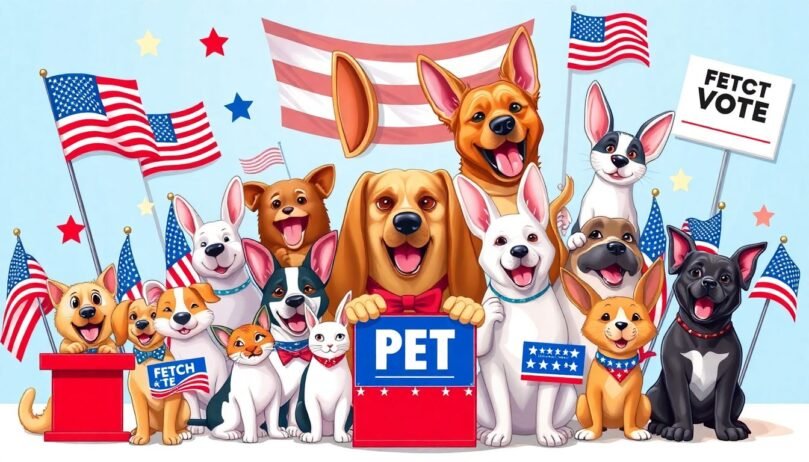The Pets Who Have Run for Political Office in the US
- 29 January 2025
- BuyAPet Editorial Team
- All Dogs, Dog Health
Civic Curiosities — The Amazing Animals Who Ran for Political Office: A Tail of Two Tickets
From goat mayors to memeable moggies—how critters shook up campaigns, sparked satire, and boosted voter engagement.
In 2015, a goat named Billy ran for mayor in a small Alaska town—more stunt than statesmanship, but it won hearts and headlines. This piece explores the captivating U.S. history of pets in politics, the strategies behind mascot campaigns, and why furry faces can make serious points about power, people, and participation.
Early Days: Canine Candidates & Feline Firsts
Early 20th-century animal campaigns
- 1928: A dog named “Allie” reportedly ran for mayor in a New Jersey town—she didn’t win, but she drew a curious crowd.
- 1930s: A cat called “Mew” was promoted (tongue-in-cheek) as a presidential candidate, critiquing human politicians through satire.
These early attempts were novelties that still earned local ink—proof that paws can pull press.
Context matters
Many historic animal bids were satirical or symbolic, not formal filings. Still, they helped communities talk about trust, representation, and relief from political fatigue.
Satire · Community fun · Media buzz
The Rise of Mascot Campaigns
Animals as emotional connectors
- Pets make candidates feel approachable and human.
- Memorable images boost message recall.
- Mascots turn dry stump speeches into shareable moments.
Engagement effects
Campaigns with animal mascots often report stronger turnout at events—sometimes cited as up to a double-digit lift in attendance. Results vary, but the relatability effect is real.
Analyzing the “Political Appeal” of Animals
Behavioral cues
Voters often associate pets with loyalty, warmth, and care. Those cues can rub off on the humans beside them.
Marketing mechanics
Striking visuals (hello, bow-tied tabby) increase recall. A strong mascot can be a memory hook for the platform itself.
The 1970s–1990s: A Surge in Animal Politics
Landmark animal campaigns
In 1976, a golden retriever named “Duke” reportedly drew thousands of write-in votes for a California Senate seat—his slogan, “A Vote for Duke is a Vote for Everyone,” captured the mood and media.
Media & perception
From humorous coverage to pop-culture status, animal candidates often evolve from quirky sideshow to pointed commentary. 1990s parody figures like “John T. Dog” stirred debate about how representation should work.
Animal-welfare groups sometimes back these campaigns to spotlight humane legislation—adding advocacy to the antics.
The Internet Age: Animals & Social Media
Viral candidacies
In 2016, a dog named “Rusty” ran a viral mayoral campaign, amassing thousands of followers with playful posts and grassroots vibes.
Memes & momentum
- A single image—say, a cat in a suit—can supercharge reach.
- Memes move faster than mailers, drawing younger audiences into the conversation.
Effectiveness online
- Social content can lift awareness and event turnout.
- Humor + visuals = higher share rates.
- Consistent engagement tends to mobilize more first-time participants.
Analyzing the “Why”: Motives Behind Animal Candidacies
Satire & commentary
Putting a pet on the ballot calls out political absurdities and invites fresh debate about leadership and accountability.
Awareness & fundraising
Some runs channel attention into animal welfare or local causes—like “Mayor Mutt” in 2018 raising funds for a humane society. When campaigns feel exclusive, an animal candidate can be the icebreaker that brings new voices into the room.
Participation boost
Unusual campaigns spark curiosity, which can nudge non-voters to register, show up, and engage in civic life—sometimes for the first time.
The Legacy of Animals in Politics
Enduring impact
Animal candidacies challenge what a “candidate” represents, opening space for creativity and critique in the public square.
Lessons learned
- Relatability is a superpower.
- Humor can deliver serious messages.
- Authenticity builds durable engagement.
Future trends
As platforms evolve, expect more creative twists—perhaps even virtual pets on the ticket—blending tech with tradition to keep voters clicking and thinking.
Conclusion & Key Takeaways
- Animal candidates use humor and heart to cut through political noise.
- Mascots can amplify messages and widen participation.
- Advocacy ties give campaigns real-world impact beyond the punchline.
Note: Many examples are symbolic or satirical; details and outcomes vary by place and time.
